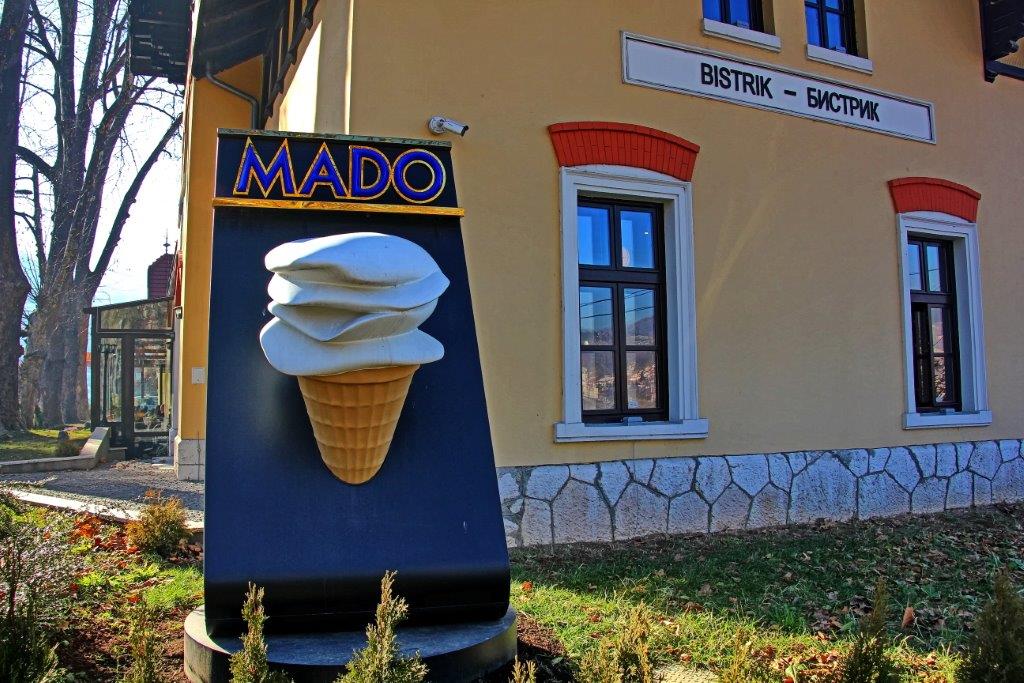The Bistrik Railway Station was located on the former narrow-gauge “Eastern railway” (Ostbahn), from Sarajevo to Višegrad and Vardište, with branches to Foča/Miljenina and Uvac/Priboj. It was built in 1906, when it was put into operation. The project for this building was made by the Technical Department of Bosnia and Herzegovina State Railways.
The Station building was constructed as a typical project (the same station building was built in Pale), by an unknown architect. With its accentuated sloping roofs and richly processed wooden eaves, it is an example of the “Alpine or Romantic style” of the architecture of the Austro-Hungarian period.
Eastern Railway
The building is located in the Bistrik settlement, on the slopes of Trebević, in the Old Town of Sarajevo. The building is built on a dominant elevation, and this area is presented in the form of a plateau-island, which is limited by frequent traffic roads – the main city bypass, and the streets of Garaplina and Huremuša. From the plateau, in front of the railway station building, there is a wide view of the city.
The appearance of the old settlement was completely changed by the construction of the station building, as well as its accompanying facilities – the buffet, the manager’s building and the cargo warehouse, as well as the construction of the embankment, tunnel and bridge. In addition to the waiting room, the facility also had counters, rooms for the dispatcher and the station chief, a smaller facility for lubrication, water filling, fountains were also installed at the stations with water and a small storage for charcoal. The overall image of the environment was not destroyed by the construction of cellular buildings, the complex fit relatively well into the overall image of this part of Bistrik.
The plans for the “Eastern Railway” towards Višegrad showed that this difficult route is not profitable, because it is expensive and demanding. The Austro-Hungarian Monarchy, a superpower at the time, was not afraid to engage in the realization of a strategically important route, so they insisted on that section because of the logistical connection to Serbia, and later, in terms of trade, it significantly contributed to the economic strengthening of our country.
It is historically proven and remembered that at that time the government of the country complained to the monarchy that it was “too expensive a project”, so they turned to Emperor Franjo Josip because of the large number of tunnels and bridges. To that he told them: “If a meter of railroad costs a kilogram of gold, you shall build it.”
Before the abolition of the narrow-gauge railway, its beauty was shown by the director Hajrudin Šiba Krvavac in the film “Walter defends Sarajevo” from 1972, where some of the key scenes took place right at Bistrik Station and around it. With the abolition of narrow-gauge railways in 1978, all of that disappeared. With the abolition of the “Eastern Railway”, the Bistrik Station building completely lost its basic significance.
Until the renovation, which was completed in 2022, the Bistrik Station building was in poor structural condition, partly due to the war and partly due to inadequate construction interventions. The building was used as a residential space, having undergone a series of constructive interventions, in order to obtain five housing units for five families.
National Monument
The installation of partition walls for the needs of residential units, as well as interventions on the facades in the form of new entrances and window openings, damaged its authenticity. The southeast platform facade was particularly degraded by the demolition of the wooden columns of the portico and the construction of a wall with new inadequate openings. When it comes to the other parts of the complex, only ruins remain, while a road was built in the form of a city bypass in the place where the railway was located.
The building of the old railway station in Bistrik was declared a national monument in 2006 by the decision of the Commission for the Preservation of National Monuments of Bosnia and Herzegovina. The renovation began in October 2020, and it was officially put back into use on April 6, 2022.
The renovated building of the railway station is divided into two parts, one of which is a catering area, while the other part should be a museum, but during our visit the museum display inspired by the film “Walter defends Sarajevo” on the second floor was not in operation.
As far as the catering part is concerned, a “full hit” was achieved, because in October 2023, a restaurant from the Turkish chain “Mado” was opened, which offers visitors a pleasant stay and enjoyment in this historically significant building.
Author: Tarik Dreca























